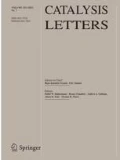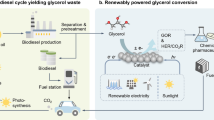Abstract
Light olefins (C2–C5) are high-value platform chemicals used to produce plastics, lubricants, coating material, and surfactants, and can be intermediates to produce transportation fuels. In this study we report on the development of a Co-based catalyst for direct conversion of fossil as well as biomass derived syngas into light olefins that enables high conversion and olefin/paraffin (O/P) product ratio, minimal selectivity to CO2 (< 1%) and wax formation (C14+ selectivity < 1%). Over a Co/HZSM-5 bi-functional catalyst 38% CO conversion with C2–C5 olefin selectivity of 48%, and O/P ratio of 4.0 was achieved at 240 °C, 17 bar, and 1.5 L/(g–h). In addition to a gaseous olefin-rich stream a C6–C13 mixed olefin/paraffin liquid byproduct was also produced with 25% selectivity. Both Co loading and the HZSM-5 acidity levels were optimized to maintain the balance between the hydrogenation and the cracking activity to generate high levels of C2–C4 olefins. A suite of catalyst characterization tools were used to correlate the physical and chemical property of the catalyst to the performance of the catalyst towards syngas conversion and C2–C4 olefin selectivity.
Graphic Abstract
Direct conversion of syngas into specialty chemicals (light/gaseous olefins) as well as liquid hydrocarbons over cobalt-HZSM-5 catalysts.








Similar content being viewed by others
References
Peacock D, Majid A, Gaffney G (2015) Unconventional resources: the next generation. Assessing coal to liquids, oil shale, underground coal gasification, microbial coal conversion and other technologies within the SPE-PRMS, in SPE/IATMI Asia pacific oil & gas conference and exhibition. Society of Petroleum Engineers, Nusa Dua
Huber GW, Iborra S, Corma A (2006) Synthesis of transportation fuels from biomass: chemistry, catalysts, and engineering. Chem Rev 106(9):4044–4098
Tan ECD et al (2017) Comparative techno-economic analysis and process design for indirect liquefaction pathways to distillate-range fuels via biomass-derived oxygenated intermediates upgrading. Biofuels Bioprod Biorefin 11(1):41–66
Smith C et al (2016) Conversion of syngas-derived C2+ mixed oxygenates to C3–C5olefins over ZnxZryOzmixed oxide catalysts. Catal Sci Technol 6(7):2325–2336
Dagle RA et al (2020) Ethanol as a renewable building block for fuels and chemicals. Ind Eng Chem Res 59:4843
Subramaniam S et al (2020) Direct catalytic conversion of ethanol to C5+ ketones: role of Pd–Zn alloy on catalytic activity and stability. Angew Chem Int Ed. https://doi.org/10.1002/anie.202005256
Urban B et al (2017) Flash pyrolysis of oleaginous biomass in a fluidized-bed reactor. Energy Fuels 31(8):8326–8334
Maddi B, Viamajala S, Varanasi S (2011) Comparative study of pyrolysis of algal biomass from natural lake blooms with lignocellulosic biomass. Bioresour Technol 102(23):11018–11026
Maddi B et al (2016) Quantitative characterization of the aqueous fraction from hydrothermal liquefaction of algae. Biomass Bioenerg 93:122–130
Dagle VL et al (2016) Integrated process for the catalytic conversion of biomass-derived syngas into transportation fuels. Green Chem 18(7):1880–1891
Ramasamy KK et al (2015) Direct syngas hydrogenation over a Co-Ni bimetallic catalyst: Process parameter optimization. Chem Eng Sci 135:266–273
Mapamba LS, Conradie FH, Fick JIJ (2016) Technology assessment of plasma arc reforming for greenhouse gas mitigation: a simulation study applied to a coal to liquids process. J Clean Prod 112:1097–1105
Griffin DW, Schultz MA (2012) Fuel and chemical products from biomass syngas: a comparison of gas fermentation to thermochemical conversion routes. Environ Prog Sustain Energy 31(2):219–224
Qiu T et al (2017) SAPO-34 zeolite encapsulated Fe3C nanoparticles as highly selective Fischer-Tropsch catalysts for the production of light olefins. Fuel 203(Supplement C):811–816
Torres Galvis HM, de Jong KP (2013) Catalysts for production of lower olefins from synthesis gas: a review. ACS Catal 3(9):2130–2149
Li J et al (2018) Integrated tuneable synthesis of liquid fuels via Fischer-Tropsch technology. Nat Catal 1(10):787–793
Khodakov AY, Chu W, Fongarland P (2007) Advances in the development of novel cobalt Fischer−Tropsch catalysts for synthesis of long-chain hydrocarbons and clean fuels. Chem Rev 107(5):1692–1744
Hodala JL et al (2016) Hydrocracking of FT-wax to fuels over non-noble metal catalysts. Fuel 185:339–347
Rafati M et al (2017) Techno-economic analysis of production of Fischer-Tropsch liquids via biomass gasification: the effects of Fischer-Tropsch catalysts and natural gas co-feeding. Energy Convers Manag 133:153–166
Lu Y et al (2017) Fischer-Tropsch synthesis of olefin-rich liquid hydrocarbons from biomass-derived syngas over carbon-encapsulated iron carbide/iron nanoparticles catalyst. Fuel 193:369–384
Bruijnincx PCA, Weckhuysen BM (2013) Shale gas revolution: an opportunity for the production of biobased chemicals? Angew Chem Int Ed 52(46):11980–11987
Zhao Z-J, Chiu C-C, Gong J (2015) Molecular understandings on the activation of light hydrocarbons over heterogeneous catalysts. Chem Sci 6(8):4403–4425
Chowdhury AD et al (2014) Towards a practical development of light-driven acceptorless alkane dehydrogenation. Angew Chem 126(25):6595–6599
Torres Galvis HM et al (2012) Supported iron nanoparticles as catalysts for sustainable production of lower olefins. Science 335(6070):835–838
Kang S-H et al (2010) ZSM-5 supported iron catalysts for Fischer-Tropsch production of light olefin. Fuel Process Technol 91(4):399–403
Zhai P et al (2016) Highly tunable selectivity for syngas-derived alkenes over zinc and sodium-modulated Fe5C2 catalyst. Angew Chem Int Ed 55(34):9902–9907
Murugesan V et al (2019) Thermally activated nucleation and growth of cobalt and nickel oxide nanoparticles on porous silica. J Vacuum Sci Technol A 37(3):031101
Zhang G, Scott BL, Hanson SK (2012) Mild and homogeneous cobalt-catalyzed hydrogenation of C=C, C=O, and C=N bonds. Angew Chem 124(48):12268–12272
Zhong L et al (2016) Cobalt carbide nanoprisms for direct production of lower olefins from syngas. Nature 538(7623):84–87
Zhao Z et al (2018) Insight into the formation of Co@Co2C catalysts for direct synthesis of higher alcohols and olefins from syngas. ACS Catal 8(1):228–241
Jiao F et al (2016) Selective conversion of syngas to light olefins. Science 351(6277):1065–1068
Sartipi S et al (2014) Insights into the catalytic performance of mesoporous H-ZSM-5-supported cobalt in Fischer-Tropsch synthesis. ChemCatChem 6(1):142–151
Sartipi S et al (2013) Hierarchical H-ZSM-5-supported cobalt for the direct synthesis of gasoline-range hydrocarbons from syngas: Advantages, limitations, and mechanistic insight. J Catal 305:179–190
Subramanian V et al (2016) The role of steric effects and acidity in the direct synthesis of iso-paraffins from syngas on cobalt zeolite catalysts. ChemCatChem 8(2):380–389
Sartipi S et al (2013) Breaking the Fischer-Tropsch synthesis selectivity: direct conversion of syngas to gasoline over hierarchical Co/H-ZSM-5 catalysts. Catal Sci Technol 3(3):572–575
Brosius R, Fletcher JCQ (2014) Hydrocracking under Fischer-Tropsch conditions; the effect of CO on the mass transfer resistance by metal clusters. J Catal 317:318–325
Rahimi N, Karimzadeh R (2011) Catalytic cracking of hydrocarbons over modified ZSM-5 zeolites to produce light olefins: a review. Appl Catal A 398(1):1–17
Mochizuki H et al (2012) Effect of desilication of H-ZSM-5 by alkali treatment on catalytic performance in hexane cracking. Appl Catal A 449:188–197
Blay V et al (2017) Engineering zeolites for catalytic cracking to light olefins. ACS Catal 7:6542–6566
Davis BH (2001) Fischer-Tropsch synthesis: current mechanism and futuristic needs. Fuel Process Technol 71(1):157–166
Udaya V, Rao S, Gormley RJ (1990) Bifunctional catalysis in syngas conversions. Catal Today 6(3):207–234
Meusinger J et al (1994) Cracking of n-heptane on metal-free H-ZSM-5 zeolite at high hydrogen pressure. J Catal 148(1):30–35
Lin Q et al (2016) Insights into the promotional roles of palladium in structure and performance of cobalt-based zeolite capsule catalyst for direct synthesis of C5–C11 iso-paraffins from syngas. J Catal 344:378–388
Bessell S (1993) Support effects in cobalt-based fischer-tropsch catalysis. Appl Catal A 96(2):253–268
Xing C et al (2015) Tunable isoparaffin and olefin synthesis in Fischer-Tropsch synthesis achieved by composite catalyst. Fuel Process Technol 136:68–72
Davidson SD, Sun J, Wang Y (2016) The effect of ZnO addition on H2O activation over Co/ZrO2 catalysts. Catal Today 269:140–147
Dehghan R et al (2011) In-Situ reduction of promoted cobalt oxide supported on alumina by environmental transmission electron microscopy. Catal Lett 141(6):754
Storsæter S et al (2005) Characterization of alumina-, silica-, and titania-supported cobalt Fischer-Tropsch catalysts. J Catal 236(1):139–152
Zhao W et al (2015) The influence of hierarchical zeolite composition and pore structure on behavior of cobalt-based Fischer-Tropsch synthesis catalysts. J Porous Mater 22(4):1097–1104
Steen EV et al (1996) TPR study on the preparation of impregnated Co/SiO2catalysts. J Catal 162(2):220–229
Kang S-H et al (2014) Fischer-Tropsch synthesis of the promoted Co/ZSM-5 hybrid catalysts for the production of gasoline range hydrocarbons. Modern Res Catal 03(03):8
Xiong H et al (2005) Catalytic performance of zirconium-modified Co/Al2O3 for Fischer-Tropsch synthesis. J Mol Catal A Chem 231(1):145–151
Santos VP et al (2015) Metal organic framework-mediated synthesis of highly active and stable Fischer-Tropsch catalysts. Nat Commun 6:6451
Bukur DB et al (1997) Effect of process conditions on olefin selectivity during conventional and supercritical Fischer−Tropsch synthesis. Ind Eng Chem Res 36(7):2580–2587
Muleja AA et al (2017) Variation of the Short-Chain Paraffin And Olefin Formation Rates With Time For A Cobalt Fischer-Tropsch catalyst. Ind Eng Chem Res 56(2):469–478
Ma W-P, Ding Y-J, Lin L-W (2004) Fischer−Tropsch synthesis over activated-carbon-supported cobalt catalysts: effect of Co loading and promoters on catalyst performance. Ind Eng Chem Res 43(10):2391–2398
Ordomsky VV et al (2017) Soldering of iron catalysts for direct synthesis of light olefins from syngas under mild reaction conditions. ACS Catal 7:6445–6452
Tian Z et al (2017) Fischer-Tropsch synthesis to light olefins over iron-based catalysts supported on KMnO4 modified activated carbon by a facile method. Appl Catal A 541(2):50–59
Meusinger J, Corma A (1995) Activation of hydrogen on zeolites: kinetics and mechanism of n-heptane cracking on H-ZSM-5 zeolites under high hydrogen pressure. J Catal 152(1):189–197
Author information
Authors and Affiliations
Corresponding author
Additional information
Publisher's Note
Springer Nature remains neutral with regard to jurisdictional claims in published maps and institutional affiliations.
Electronic supplementary material
Below is the link to the electronic supplementary material.
Rights and permissions
About this article
Cite this article
Maddi, B., Davidson, S., Job, H. et al. Production of Gaseous Olefins from Syngas over a Cobalt-HZSM-5 Catalyst. Catal Lett 151, 526–537 (2021). https://doi.org/10.1007/s10562-020-03324-7
Received:
Accepted:
Published:
Issue Date:
DOI: https://doi.org/10.1007/s10562-020-03324-7




